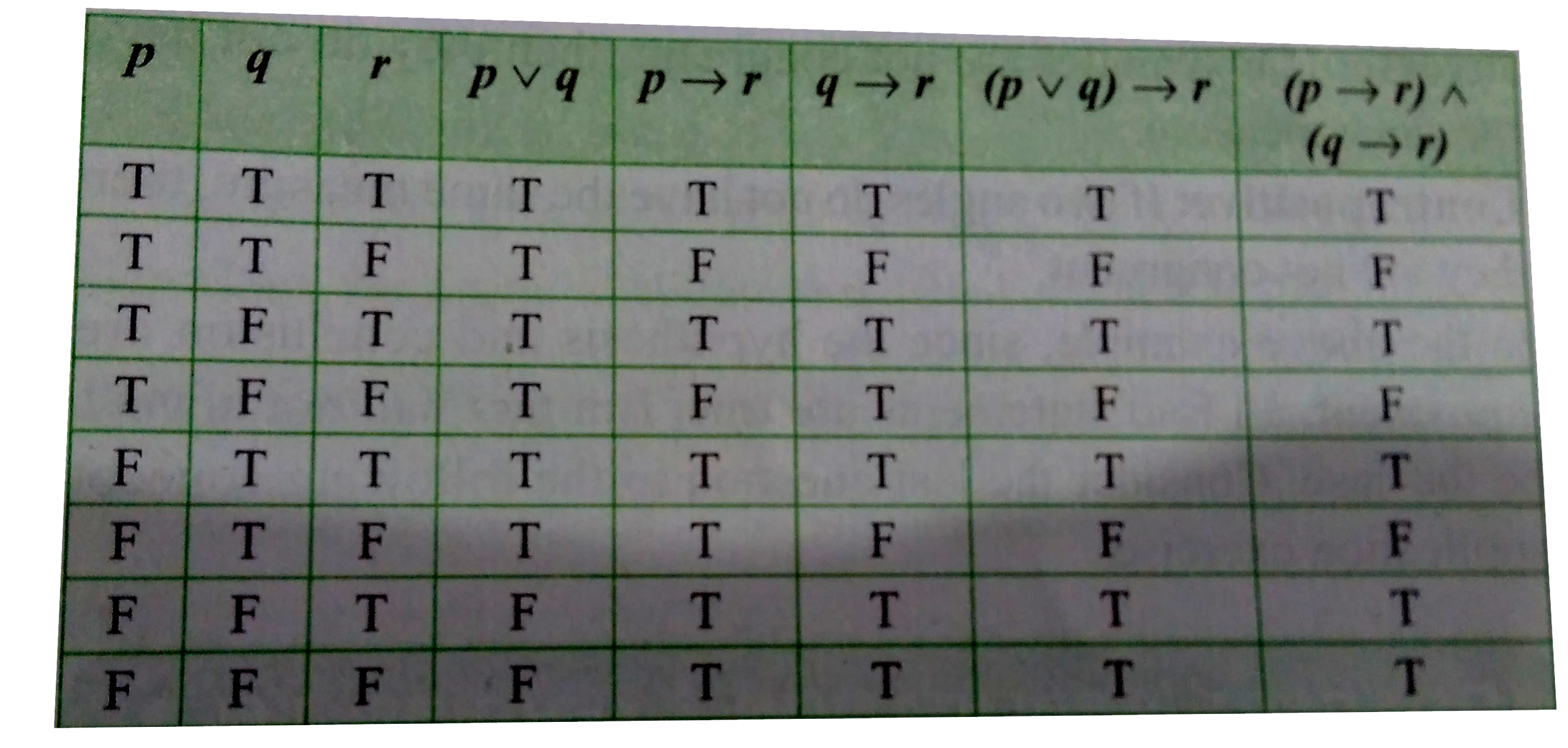Show that (p∨q)→r≡(p→r)∧(q→r) Solution in Bengali
Truth table for (p∨q)→r and (p→r)∧(q→r).

It is evident from the last two columns that
(p∨q)→r≡(p→r)∧(q→r)
Note:
1p→q≡(~p)∨q
2.p↔q≡(p→q)∧(q→p)
3.p↔q≡(~p∨q)∧(p∨~q)
Topper's Solved these Questions
- MATHMETICAL REASONINGBOOK - CENGAGE PUBLICATIONCHAPTER - MATHMETICAL REASONINGEXERCISE - concept application
13 Videos
- MATHMETICAL REASONINGBOOK - CENGAGE PUBLICATIONCHAPTER - MATHMETICAL REASONINGEXERCISE - Single correct answer type
38 Videos
- LOGARITHM AND ITS PROPERTIESBOOK - CENGAGE PUBLICATIONCHAPTER - LOGARITHM AND ITS PROPERTIESEXERCISE - JEE ADVANCED
1 Videos
- MATRICESBOOK - CENGAGE PUBLICATIONCHAPTER - MATRICESEXERCISE - All Questions
509 Videos
Similar Questions
Write down the truth table for the compound statements :
(~p∨q)∧(~p∧~q)
View SolutionWhich of the following is not a statement.
View SolutionLet (x0,y0) be the solution of the following equations: (2x)1n2=(3y)1n3 31nx=21ny The x0 is 16 (b) 13 (c) 12 (d) 6
View SolutionIn which of the following type of matrix inverse does not exist always? a. idempotent b. orthogonal c. involuntary d. none of these
View SolutionShow that ∣∣ ∣ ∣∣0p−qp−rq−p0q−rr−pr−q0∣∣ ∣ ∣∣=0
View SolutionThe logical statement [~(~p∨q)∨(p∧r)]∧(~q∧r) is equivalent to (a) (~p∧~q)∧r (b) ~p∨r (c) (p∧r)∧~q (d) (p∧~q)∨r
View SolutionShow that (p∨q)→r≡(p→r)∧(q→r)
View SolutionConstruct the truth table for the followings statements :
(a) (p∧q)→~p (b)(p∧q)→(p∨q)
(c) (p∧q)→r (d)[p∧(~r)]→(q∨r)
View SolutionIf the statements p and q are true and the statement r and s are false, find the truth values of :
(1) ~[(p∨q)∧~r]∧{[(~p∨q)∨(~r)]∨s}
(2) p∧[q∧(~p∧r)∨~s]∨~r.
View SolutionIf the statement p and q are true and the statements r and s are false, fing the truth values of :
(1) (~p∨q)→(s∧~r)
(2) [p∧(q∧r)]∨[(p∨q)∧(~r∨s)]
(3) ~[(~p∧r)∨(s→~q)]⇔(p∧r).
View Solutionकिन्ही तीन कथनो p,q व r के लिए सिद्ध कीजिये कि
p∨(q∧r)≡(p∨q)∧(p∨r)
View SolutionIf p, q, r be anY three. statements
STATEMENT-1 : p∨(q∧r)⇔(p∨q)∧(p∨r)
and
STATEMENT-2 : p∨(q∧r)=(p∨q)∧(p∨r)
View SolutionIf p, q and r are simple propositions, then (~pvvq) rarr r If true, p, q and r will be respectively
View SolutionShow that (p∨q)→r≡(p→r)∧(q→r)
View SolutionConstruct the truth table for the followings statements :
(a) (p∧q)→~p (b)(p∧q)→(p∨q)
(c) (p∧q)→r (d)[p∧(~r)]→(q∨r)
View SolutionThe logical statement [~(~p∨q)∨(p∧r)]∧(~q∧r) is equivalent to (a) (~p∧~q)∧r (b) ~p∨r (c) (p∧r)∧~q (d) (p∧~q)∨r
View Solution
